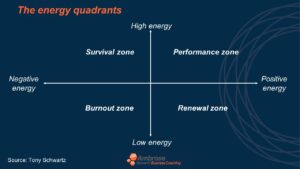I would be a terrible professional athlete. Not just because of my complete lack of athletic talent. The biggest issue is: I have a hard time taking a break – I am restless. And yet as eight-time Olympic gold medalist Usain Bolt put it, resting is key for peak performance: “You need to rest and recover, in order for the training to be absorbed by your body.”
This is also the case in business: the greater the performance demand in your job, the greater the need for recovery. When you skip recovery, your and your team’s performance gradually slips – and your business growth quietly slows down.
Recharging your batteries is an integral part of your job – just as it is for top athletes. What constitutes a good recharging break?
What happens when you don’t properly manage your energy?
“Putting in long hours and thinking constantly about work makes it harder to be fully engaged in your jobs,” according to Tony Schwartz – who helps executives perform at their best. “Over time, it leads to diminishing productivity, higher rates of burnout, and even to increased likelihood of mortality”, according to this 2021 World Health Organization study.
Tony Schwartz illustrates this in this HBR article with the 4 energy zones:
- The Performance zone is where you want to be when you need to be at your best. Your energy is high and positive, you feel upbeat, and engaged, and you work at your highest level.
- When you stay too long in your Performance zone though, you end up in the Survival zone – where you are “anxious, impatient, irritable, fearful, self-critical,” narrow-minded, or cynical. The quality of your decisions drastically degrades because of a tunnel vision Over time this can lead to the Burnout zone.
- The key to sustainable high performance is to “to move regularly and deliberately” to your Renewal zone – where you can recharge your batteries before getting back into your Performance zone. In the Renewal zone, you feel “tranquil, serene, mellow, and peaceful.”

Not every break helps you recharge your batteries
Regularly moving between your Performance and Renewal zones does not mean being idle. A good break gives you energy and makes you feel fulfilled. A bad break consumes energy.
Strategically select your resting activities. Unplug from energy-draining activities and plug into recharging activities. For some, this might involve yoga, for others running a marathon. For some, this might include reading, for others partying with friends.
Kevin Lawrence in Your Oxygen Mask First recommends three types of breaks:
Take care of your mind, e.g.:
- Spend time on things that require focused attention – like reading a captivating novel or solving puzzles.
- Best-selling author Shirzad Chamine has developed a very practical, on-the-go method to strengthen your mental fitness. Contact me to find out more (Xavier@AmbroseGrowth.com).
- Disconnect from work-related temptations (e.g. email, phone,…).
Take care of your body, e.g.:
- Exercise regularly (e.g. gym, yoga, hiking) – mens sana in corpore sano is scientifically demonstrated.
- Eat healthy and sleep at least 7 to 8 hours per night.
Take care of your spirit by doing things that light you up inside, e.g.:
- Spend quality time with people you love, in situations where you can give them your undivided attention – e.g. dinner with your family.
- Do something that you genuinely enjoy, just like a child – whatever it is: car racing, rock climbing, gardening, playing with lego’s or model trains.
- Volunteer at a local non-profit – which, as an aside, “substantially lowers the risk of early death”, according to the Harvard School of Public Health.
As the CEO you are the Chief Energy Officer. If you better manage your energy, so will your team members – and your team’s performance level will increase.
What is one thing that you will do differently this week to recharge your batteries?
I work with growth-minded CEOs who are frustrated by the way their business is growing; often they spend their days fighting fires – typically a sign that their company has outgrown their management approach. Often they spend much time fighting fires and have only little left to grow their business. I know the feeling: I have been in their shoes when I was running a business that we turned around from sales decline to double-digit business growth.
As a business coach my passion is to help leadership teams define their actionable business growth strategy, create a culture of accountability and effective strategy execution, and become better leaders – so they can grow faster and with less pain. I work with clients in the US and in Europe (mostly in Belgium, The Netherlands, and France)
If you too want to grow faster and with less pain, contact me now: Xavier@AmbroseGrowth.com.

“My company has lots of potential, but I just feel my employees are not engaged. If I don’t push, nothing seems to happen. I’m working night and day and we’re still missing 40% of our targets. I once dreamed of being a firefighter, I guess that dream has come true. All I do is put out fires, I have no time to focus on my business.”
Sound familiar? CEOs and leadership teams can change this picture, it’s all about accountability. Creating a fierce culture of accountability starts with the CEO and leadership team.
Why is accountability important?
Accountability is about owning a problem. You want employees to behave as if they own the piece of business that they are running. When you are accountable for a specific result, you will do whatever it takes to achieve it – and you would like your team to perform this way as well.
Carlos Brito, the CEO of brewing company AB Inbev, summarizes his views on accountability in these words: “We always compare that to a rental car: you drive a rental car in a different way than your own car. With a rental car someone else will live with the consequences of your driving. With your car, you know that it will be yours the next days, months, and years, and you know that you will be living with the consequences of your driving. Employees who behave like owners are here for the long term, and they will live with the consequences of their decisions – good or bad – and that builds a great company.”
Why am I having accountability issues?
Accountability issues are very common among growing companies. When you founded your company, you were personally accountable for everything. As your company grew you started delegating the responsibilities for some results – e.g. production, customer service, or sales. However, you may not have created the communication channels required to hold your teams accountable. Why would you? You didn’t need any of this yourself, and yet you grew your business successfully. Why would these smart managers need anything different?
For one, your employees are not you. If they were, they would not be working for you: they would start their own business. Second, your company is now more complex than we you started: it has more people involved, and all these people now need to be on the same page. Third, when you started your company with a few employees, you could be on top of each of them and had short communication lines: you knew what everybody was doing, all the time. Now that your company has more employees it is impossible for you to manage them the same way: this would soak up all your time. This is exactly why you need to put a system in place that will achieve what you want (ie create accountability), without you spending all your time on it.
In the book “Creating a Culture of Accountability” Gravitas Impact business coach Mark Green describes ways to increase your team’s accountability. This article outlines five of them
1. Lead by example
Like many aspects related to company culture, accountability starts with you and your leadership team. In order to create a culture of accountability you have to model the behaviors that you want to see in your organization. When it comes to accountability the rule is simple: when you make a commitment as a leader, you have to keep it. If you don’t, why should anyone else be interested in doing so? You can’t complain that employees miss their deadlines if you are occasionally late as well. As a CEO “all eyes and ears within your business are focused on you. What you say and what you do are invisibly and constantly observed, scrutinized and evaluated as your managers and employees are looking for clues as to how they should behave,” explains Mark Green.
Leading by example is not only about you sticking to your commitments, but also about your expectations from your team – and your behavior when your managers don’t meet your expectations. If your team members notice that there are no consequences for missing targets, why would they try their best? Similarly, if you tolerate one of your team members to produce poor results, why would other team members feel pressured to produce quality? When you hold your team to a higher standards, you are sending a strong signal across the organization.
2. Have the right people on the right seat
Without the right people on the right seat, nothing of what you can do will significantly increase accountability. The key question is: would you enthusiastically rehire everybody on your team? I advise my clients to assess employees on two dimensions; performance and adherence to company values. You will find more information on how to use this tool in this article.
Once you have the right people on your team you need to clarify their area of accountability. This is less obvious than it looks. The key question is: Who is accountable for each of the key functions in your company? As Mark Green explains “the exercise often reveals that there isn’t a single individual accountable for each function. When more than one person is “accountable”, nobody is accountable. It is easy to make assumptions that things will get done, but when there is not a designated person to account for a particular result, chances are, it is not going to happen. In this kind of environment, it is also easy to point fingers – Bob thought Mary would handle it, and vice versa. Other times, you’ll discover that a particular role hasn’t been filled by anyone at all; it is just implied that it will somehow be handled. Spoiler alert: it doesn’t!”
3. Clarify priorities
“The main thing is to keep the main thing the main thing,” wrote best-selling author Stephen Covey. “Individuals or organizations with too many priorities have no priorities and risk spinning their wheels and accomplishing nothing of significance,” says Verne Harnish in his book “Scaling Up.” Focus on a small number of priorities that will have the biggest impact on your goals, make sure that everyone on your leadership team is aligned on them – and communicate them broadly.
When employees understand where your organization is going and which role they play in it, they work less selfishly and they tend to make better business decisions on behalf of the company – simply because they can see the impact of their decisions and how they impact overall results.
4. Define clear action plans and metrics
Once you have identified who on the leadership team is accountable for each function and what your top priorities are, the next step is for each of your leaders to answer Mark Green’s key question: “What are the 3 most important results the company expects you deliver in exchange for paying your salary – and how should these results be measured? This step determines the results and metrics for each of your leadership functions. As we all know, you can’t manage what you don’t measure. If you want to increase the speed and quality of a particular service you offer, you should establish specific metrics to gauge those factors and identify metrics and targets for them. You may determine if you reach or surpass a target for three months in a row, you have achieved that objective.” Pick specific metrics, make sure that your leadership team is on the same page and that everybody aims for the clearly defined results – so that the rest of your organization can follow your lead.
Similarly, once you have defined top quarterly priorities, the question becomes: what do you and your team need to do in each of the next 13 weeks in order to achieve priorities? There are only 13 weeks in a quarter – if you do NOT view your quarter as a 13-week race, you will lose weeks and time which you will NOT get back. A weekly plan clarifies what can be expected every week, in order to meet expectations at the end of the quarter. It also makes it much easier for your leadership team to hold people accountable to their own 13-week plan.
5. Establish a metronome-like meeting rhythm
Just as a metronome calls time and sets tempo in a musical performance, so do a small set of consistently executed meetings to hold you and your team accountable, and keep everyone on the same page. The essential regular meetings are:
- Daily huddles (no more than 10 to 15 minutes) to evaluate progress on the very short-term priorities and identify any blocking issues.
- Weekly huddles (no more than 90 minutes) to review the status of the 13-week plan and course-correct if needed.
- Monthly and quarterly meetings to review progress on the priorities, take corrective actions when needed, and identify new priorities for the upcoming quarter.
I often notice that the most impactful meetings to drive accountability are the daily and weekly huddles: they create peer pressure and hence take the heat off your shoulders as the leader. They also improve communication: You won’t need to have the same water-cooler conversation three of four times, as is the case when you rely on chance hallway meetings for communication. And finally they enable collective intelligence to solve problems.
Conclusion
In the end, how much difference do these tools make on accountability? Pretty big, as this example from another Gravitas Impact business coach, Glen Dall, demonstrates in Mark Green’s book “Creating a Culture of Accountability”: “I worked with the CEO of a multi-location dental practice. The CEO had started with one practice that they grew very successfully – and then began expanding. At one point employee turnover rates increased to 200%. The leadership team would plan and set goals, but frequently failed to achieve them. The growth rate was declining. The CEO felt over-extended, frustrated and stressed.”
With the leadership team Glen Dall leveraged these tools to have the right people on the right seat, set priorities and targets, as well as establish a proven system to follow up on them. The result? “After our first 6 months of working together, the CEO told me, “You should be proud of how far you’ve brought the team. I feel that we have accomplished more in the past 6 months than we were able in the last 7 years.” That is the power of accountability.”
As a business growth coach, I work with founders of mid-market companies who are frustrated because their business is not growing the way they want; my passion is to help them identify and remove the growth roadblocks they have been hitting so they can grow faster and with less pain. Often their roadblocks include a lack of accountability: they have no system in place to regularly follow up on their team’s many commitments, or their teams don’t have clear priorities and metrics. I would like to learn about your growth roadblocks; contact me to discuss at Xavier@AmbroseGrowth.com.
What about you? How accountable is your team? How has Covid impacted accountability? Over the past couple of years, how many quarters has your company reached and missed their targets? What were the consequences of hitting targets, and what were the consequences of missing them? Do you have clear metrics and regular meetings in place to follow up on each of your priorities?
Let me know your thoughts in the comments section.

